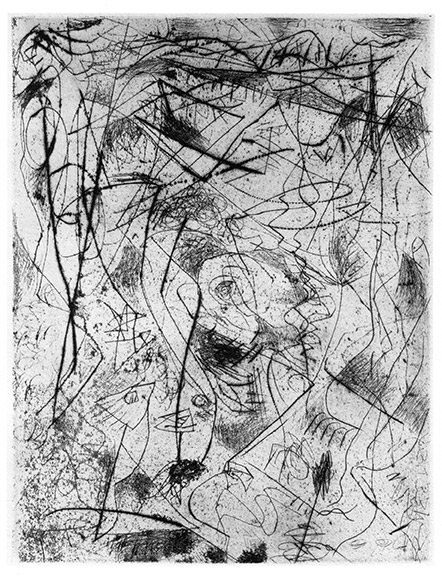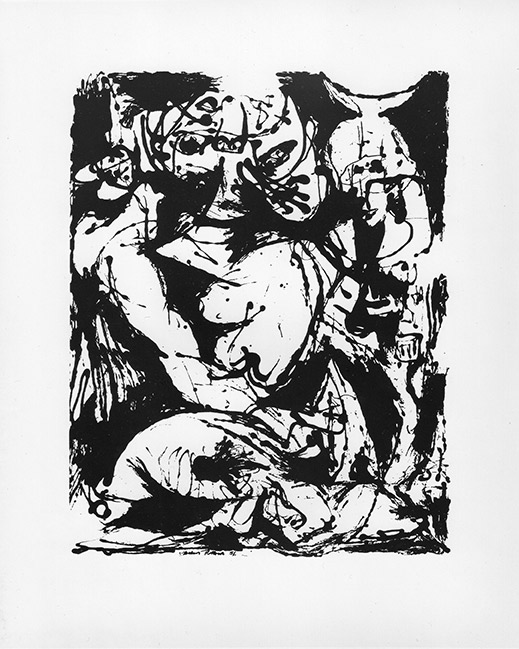Jackson Pollock is best known for his stunning abstract poured paintings from the 1950s — work which marked the high point of his artistic career. But many people may not realize that Pollock also explored the art of printmaking on the way to developing his signature style of painting.
While it was a medium he never truly embraced professionally, from 1943 through the early 1950s, Pollock did experiment with different printmaking techniques and even produced a number of small scale silkscreens and screen-printed greeting cards in his own studio.
A dozen examples of the artist’s foray into the medium will be on view March 1 to June 8, 2014 at the Long Island Museum in Stony Brook, N.Y. as part of the museum’s 75th anniversary this year. The exhibit, “Jackson Pollock’s Prints,” includes his print work and photographs of Pollock at work in his East Hampton, N.Y. studio (taken by Hans Namuth in 1950). Also on view are a few of Pollock’s personal items — most notably a sketch pencil which he drew a design on and a checkbook adorned with his whimsical doodles.
Helen A. Harrison, Director of the Pollock-Krasner House and Study Center in East Hampton, N.Y. curated the exhibit and selected works from their collection and those loaned to the Pollock-Krasner House from the Pollock-Krasner Foundation, which handles the late artist’s estate.
Works include six intaglios printed from original plates Pollock created and 1944 and ’45, and six silkscreens printed from screens made in 1951. Both sets of prints, notes Harrison, are restrikes which were done in 1964 from the original plates under the approval of the late Lee Krasner, Pollock’s widow and artist in her own right.
.

"Untitled" (after Number 22, 1951) by Jackson Pollock. Screen print, 29 x 23 inches (sheet). Printed posthumously, 1964. Pollock-Krasner House and Study Center, East Hampton, NY.
.
Pollock’s first exploration into printmaking came in the 1930s when he created at least 12 lithographs as an artist with the WPA (Works Progress Administration) Federal Art Project. However, none of those works were printed for the WPA. He began exploring printmaking again in the 1940s.
“In the early ‘40s, Pollock began experimenting with screen printing with a 5” x 5” x 7” press which he worked on at home and he created a whole series of small screen prints,” Harrison explained in a recent interview. “It was experimental and some of these became holiday cards.”
Harrison noted that Pollock’s first serious exploration of printmaking came in 1944 and 1945 when he created 11 plates using engraving and drypoint techniques at Atelier 17, Stanley William Hayter's print workshop in New York City’s Greenwich Village. Six intaglios from this period are among the works on view in the Long Island Museum show.
.

"Untitled" by Jackson Pollock, ca. 1944-45. [1078] Engraving and drypoint, 19 3/4 x 27 3/4 inches (sheet). Printed posthumously, 1967. Courtesy of the Pollock-Krasner Foundation.
It so happened that the atelier was across the street from Pollock’s apartment on East 8th Street. Harrison noted that Pollock’s best friend Reuben Kadish, who worked at the atelier, let Pollock come in after hours.
Why after hours?
“He didn’t want the other artists watching,” said Harrison. “He was self conscious, I think. He didn’t know the technique and probably didn't want the other artists’ eyes on him. His studio was a private place and even when he worked for the WPA, he wasn’t on the mural project, he was an easel painter so was used to working alone.”
As Pollock’s explorations as a painter grew, so too did his printmaking style as he synthesized the earlier influences of artists he admired like Picasso, Miro and Klee and made new work that was all his own, said Harrison.
“When you look at his engravings, you see these are original images done on the plate without sketches or preliminary pencil work,” she explained. “It’s etched directly on the copper with the burin and drypoint needle.”
.

"Untitled" by Jackson Pollock, ca. 1944-45. [1081] Engraving and drypoint, 20 x 13 5/8 inches (sheet). Printed posthumously, 1967. Courtesy of the Pollock-Krasner Foundation.
Harrison added that Hayter was not only a master printmaker, but he was also very good at marketing prints. Because prints could be produced in multiples as an edition and sold for $10 to $15 each, Hayter saw printmaking as a practical way for struggling artists to make some money.
“According to Reuben, Hayter encouraged Jackson to do that because the WPA was over and he was just showing with Peggy Guggenheim,” Harrison said. “This way, he could earn money and go to Provincetown [Mass.] in the summer with his friends.”
“Jackson made 13 plates all together [at Atelier 17], but was not satisfied with them and never made the edition, which of course didn’t sell,” she said. “So he and Lee were broke that summer.”
So while Pollock and Krasner may not have made it to Provincetown that summer, they did, through a twist of fate, end up discovering the East End of Long Island,, N.Y., where they would eventually settle.
“Reuben had a place out on Louse Point [in the Springs section of East Hampton],” Harrison explained. “Hayter and his wife, Helen Phillips, had turned it over to Reuben, and he and his wife, Elizabeth, took Jackson and Lee there. So they spent the summer there instead of Provincetown.”
And although Pollock was unsatisfied with the images he created at Hayter’s atelier, Harrison noted that the artist didn’t entirely abandon printmaking.
“He kept on going with the small screen prints – on view in the show is an example of a holiday one from 1949,” Harrison said.
Pollock next became involved in printmaking in 1951 when his friend, artist Tony Smith, suggested that he print a portfolio of his paintings. Smith reasoned that since Pollock’s paintings were selling for $1,200 at that point, he could easily get $50 for prints of his paintings.
“So Smith took photos of six of Pollock’s paintings and his brother Sandy, who had a screen print workshop, made screen prints from the photos,” Harrison said. “They were Warhol-style photo reprints and he made roughly 25 copies of each, though we’re not sure about that because Pollock only signed them when they sold.”
.
!["Untitled" (after Number 8, 1951 [Black Flowing]) by Jackson Pollock.](https://hamptonsarthub.com/wp-content/uploads/2014/02/WEB_Pollockget-attachment.jpg)
"Untitled" (after Number 8, 1951 [Black Flowing]) by Jackson Pollock. Screen print, 23 x 29 inches (sheet). Printed posthumously, 1964. Pollock-Krasner House and Study Center, East Hampton.
While the prints didn’t sell quickly, Harrison noted, they did eventually sell.
“What we have [at the Pollock-Krasner House] are reprints done in the 1960s with permission from Lee,” she said.
While Pollock’s little known prints are the stars of this show at the Long Island Museum, Harrison was hard put to contain her excitement about the everyday objects from Pollock’s life that are also on view in the exhibition, particularly the so-called “Totem Pencil.”
“I love the pencil that was discovered in Pollock’s studio not long after I started here with assistance from Chris McNamara,” Harrison recalled. “She was going through stuff in a tin can, she saw it and noticed it actually had marks on it.”
“It’s a drawing pencil with a matte wood finish and Chris saw it had imagery on it,” Harrison added. “She said, ‘Look we have a little Pollock drawing.’”
.

"Totem Pencil," by Jackson Pollock, date unknown (ca. 1939). Pencil drawings on wood pencil, length 6 5/8 inches. Pollock-Krasner House and Study Center, East Hampton.
.
So Harrison wrote it up and the “Totem Pencil” became part of the Pollock-Krasner House collection.
“It’s reimagining the pencil,” said Harrison. “How many times have you looked at a pencil? You say it needs sharpening; you don’t say it needs a drawing on it.”
But luckily for the rest of us, one of the most important American artists of the 20th century did — and now it’s a Jackson Pollock original.
BASIC FACTS: “Jackson Pollock’s Prints” will be presented March 1 to June 8, 2014 at the Long Island Museum, 1200 Route 25A, Stony Brook, N.Y. 11790. www.longislandmuseum.org.
Upcoming related programs at the museum:
Prints and Drawings of Jackson Pollock, March 30, 2014 at 2 p.m.
Guest Curator Helen Harrison discusses the development of the exhibition and provides insight into Pollock’s artistic technique.
Painting Jazz, April 27, 2014 at 2 p.m.
A look at the music which played an influential role on the art of Jackson Pollock. Presented by Loren Schoenberg, Artistic Director of the National Jazz Museum in Harlem, a Smithsonian Affiliate.
Art Across the East End, May 21, 2014 from 7:30 a.m. to 5:30 p.m.
Bus tour to Long Island’s East End for a tour of the Pollock-Krasner House, lunch at Plaza Café in Southampton, N.Y. and a guided tour of the Parrish Art Museum in Water Mill, N.Y.
Museum-Library Partnership, May 28, 2014 from 2:30 to 4:30 p.m.
A look at the culture of Long Island’s East End art scene, presented by Carolyn Emerson, Reference Librarian at the Emma S. Clark Memorial Library.
“Pollock,” June 1, 2014 at 1 p.m.
A special screening of the Oscar Award winning film “Pollock” with discussion led by Helen Harrison.
________________________
Copyright 2014 Hamptons Art Hub LLC. All rights reserved.
